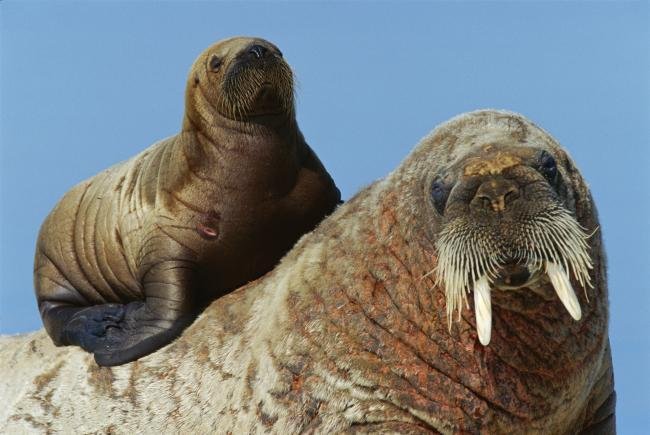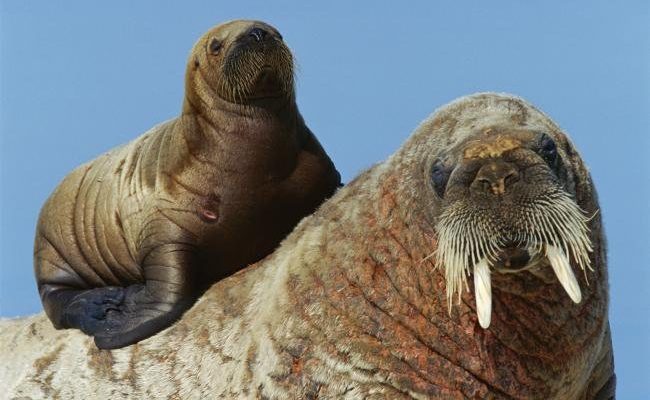
Imagine sipping your coffee while standing on a frozen shore, watching walruses basking in the sun. These massive marine mammals have a charismatic presence that draws people in. With their whiskered faces and social nature, they might appear somewhat comical at first glance. However, they are highly intelligent animals, and their behaviors and adaptations tell a rich story of survival in one of the harshest environments on Earth. Here’s what you should know about these incredible creatures.
1. The Tusks: More Than Just a Pretty Face
Walruses are perhaps best known for their long, protruding tusks, which can grow up to three feet long! Both male and female walruses have tusks, but males typically have larger ones. You might be wondering—what’s the purpose of these impressive ivory teeth? Well, they serve several important functions.
First off, tusks are handy for hauling themselves out of the water onto ice. Imagine trying to pull yourself up onto a slippery surface; those tusks act like built-in ice picks! Additionally, they play a crucial role in social interactions. Males often use their tusks to assert dominance during mating season, which can look like an intricate dance of posturing and displays of strength.
Another interesting fact is that walruses can also use their tusks for foraging. They dive to the ocean floor and use them to root around for clams and mollusks, which make up a large part of their diet. So, while they may look funny, those tusks are vital tools that assist walruses in their daily lives.
2. Social Creatures: A Community of Giants
If you think walruses are solitary animals, think again! These creatures are highly social and often gather in large groups called pods. You might catch sight of hundreds of walruses lounging together on ice floes or sandy beaches, creating a lively atmosphere.
These social gatherings aren’t just for fun; they serve essential purposes. Being social helps walruses feel safer from predators, like polar bears. They benefit from the collective vigilance of the group. Plus, it’s during these gatherings that social bonds are formed.
Interestingly, walruses have a complex social hierarchy. Males often display various behaviors to establish dominance—think of it as a walrus version of a popularity contest! Whether it’s growling, tusk sparring, or vocalizing their presence, they have their ways of interacting and communicating within their community.
3. Walrus Diet: Feasting Under the Ice
So, what do walruses actually eat? You’d be surprised by the variety in their diet! Primarily, they enjoy a feast of clams, snails, and other benthic organisms found at the ocean bottom. Imagine diving into a buffet of tasty treats, right in your backyard!
Walruses can dive up to 300 feet in search of food, holding their breath for about 30 minutes at a time. That’s impressive, especially considering their size! Once they find a delicious clam, they can suck the meat right out of the shell—no utensils needed.
In some cases, walruses are even known to hunt seals or scavenge leftovers from polar bear kills, showcasing their adaptability in finding food sources. It’s fascinating how these creatures have adjusted their diets based on the availability of food in their frigid habitat.
4. Adaptations for Extreme Conditions
Living in polar regions isn’t easy, but walruses are equipped with adaptations that help them thrive in icy waters. Their thick skin, which can be up to four inches in some areas, acts as a natural insulator against the cold. Picture wearing a thick winter coat that keeps you warm in freezing temperatures—that’s what their skin does!
Another remarkable adaptation is the layer of blubber beneath their skin. This fat layer not only provides insulation but also serves as an energy reserve. When food is scarce during harsh winters, walruses can lean on this stored energy to survive.
Moreover, walruses have a unique ability to slow their heart rate while diving, conserving oxygen. This, combined with their excellent eyesight and sensitive whiskers known as vibrissae, allows them to navigate and hunt effectively underwater. These features highlight how well-adapted walruses are to their extreme environment.
5. The Sounds of the Sea: Vocal Walruses
Have you ever heard a walrus “sing”? They’re surprisingly vocal creatures! Walruses communicate using a variety of sounds, including bell-like barks, grunts, and even high-pitched whistles. It’s like their own underwater symphony!
These vocalizations are most common during social interactions. You might imagine a bustling gathering of walruses, each one adding its voice to the chorus. The sounds help maintain their social structure and keep in touch with one another.
Interestingly, some researchers believe that the intensity and frequency of these sounds can indicate the walrus’s emotional state. Whether they are excited, alarmed, or content, their vocalizations give us a window into their feelings and social dynamics.
6. Conservation Status and Threats
Despite their resilience, walruses face numerous threats that impact their populations. Climate change is a significant concern, as melting sea ice affects their habitat and access to food. Without a stable ice platform for rest and breeding, their survival is compromised.
Moreover, increased human activity, such as shipping and oil drilling in the Arctic, poses additional risks. These disruptions can lead to habitat destruction and increased competition for food resources. Honestly, it’s concerning how quickly their environment is changing.
Conservation efforts are underway to help protect walruses. These include monitoring population numbers, regulating hunting, and advocating for policies that reduce greenhouse gas emissions. The more we understand and support walruses, the better chance they have to thrive in their chilly homes.
7. Interesting Breeding Behaviors
Breeding season for walruses is a fascinating spectacle. Typically, it occurs in late winter to early spring, and males engage in impressive displays to attract females. They might show off their tusks, vocalize, or even battle with other males to win over a mate. Imagine a talent show where only the strongest and most charismatic contestants get selected!
After mating, females typically give birth to a single pup after a gestation period of about 15 to 16 months. Walrus pups are adorable, too! They are born weighing around 100 pounds and are covered in a layer of soft fur.
Mother walruses are extremely attentive and protective of their young. They nurse their pups for about two years, teaching them vital skills and taking them along during foraging trips. The bond between mother and pup is a testament to the nurturing nature of these remarkable mammals.
8. The Role of Walruses in Their Ecosystem
Did you know walruses play an important role in their ecosystem? As foragers, they help maintain the health of the ocean floor by stirring up sediments while hunting. This activity allows nutrients to circulate, which in turn supports various marine life forms.
Additionally, by preying on clams and other bivalves, walruses help regulate these populations, ensuring a balanced ecosystem. It’s a bit like how you might trim your garden to encourage healthy growth—walruses keep the underwater community thriving!
Moreover, walruses are a food source for predators like polar bears and orcas. This interaction is vital for maintaining the balance within Arctic food webs. The presence of walruses indicates a robust environment, making them essential to understanding the health of their ecosystem.
9. Cultural Significance
Walruses have long held a significant place in the cultures of Indigenous peoples living in the Arctic. They are an essential resource for food, clothing, and tools. Many communities have deep-rooted traditions and stories surrounding walruses, reflecting their importance beyond mere survival.
For instance, the Inuit people have longstanding practices that honor walruses. They depend on them for protein and utilize their tusks and bones for various crafts and tools. Even today, these traditions are celebrated, showcasing their respect for the animal that sustains them.
In contemporary culture, walruses also appear in art and folklore, symbolizing strength and resilience. The way they connect to human culture highlights how intertwined we are with wildlife and the importance of preserving such majestic creatures.
10. Walrus Facts to Impress Your Friends
Sure, you might know a lot about walruses now, but here are some quick facts that will make you the life of the party!
- Weight: Adult walruses can weigh between 1,500 to 2,200 pounds!
- Speed: They can swim at speeds of up to 35 miles per hour in short bursts.
- Life Span: Walruses can live up to 40 years in the wild.
- Blubber: They have a thick layer of blubber that can be up to 6 inches thick.
- Breath-Holding: Walruses can hold their breath for up to 30 minutes while diving for food.
So next time you’re at a gathering and someone asks about walruses, you’ll be ready with some jaw-dropping facts that’ll make you the go-to walrus expert!
In conclusion, walruses are extraordinary animals with unique adaptations and social behaviors that make them stand out in the animal kingdom. As we continue to learn about them, it’s essential to support conservation efforts to protect their habitats and ensure their survival for the generations to come. Next time you think of the Arctic, remember the walrus and all the fascinating aspects that make it a true marvel of the marine world!

